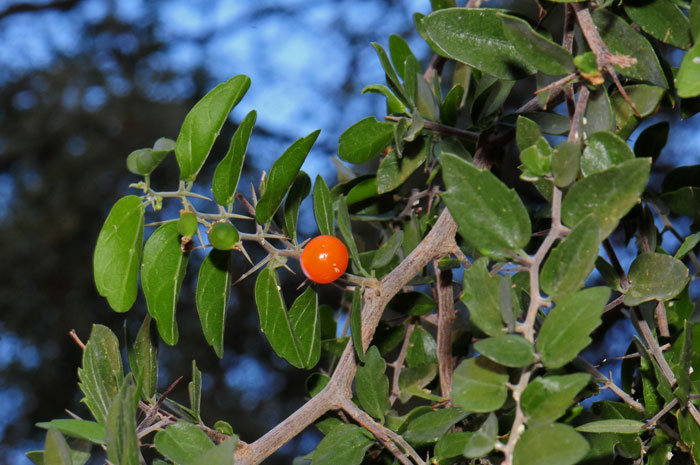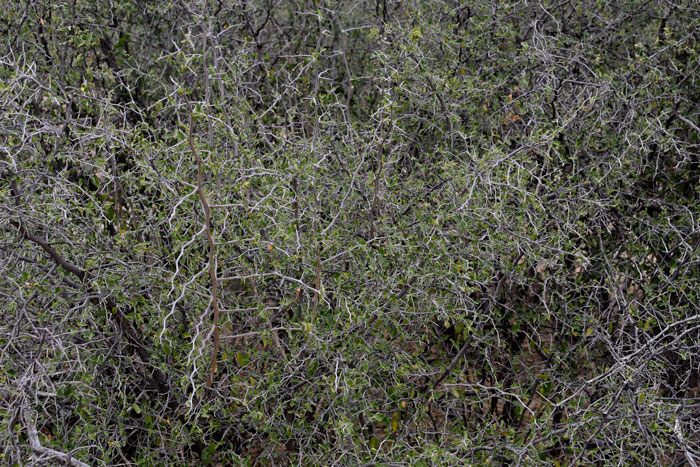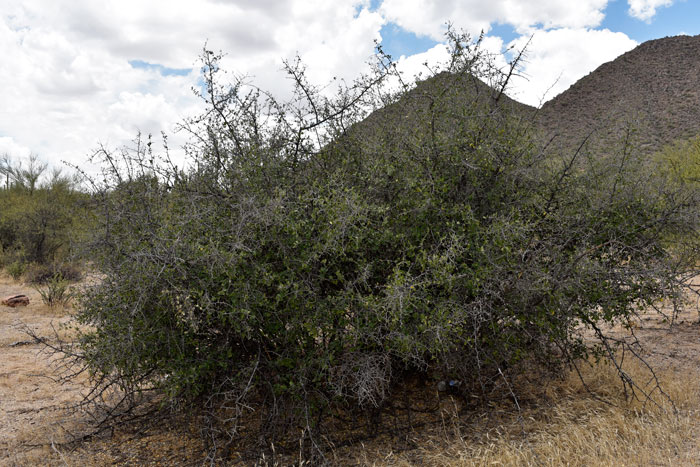Celtis pallida, Spiny Hackberry




Scientific Name: Celtis pallida
Common Name: Spiny Hackberry
Also Called: Chaparral, Desert Hackberry (Spiny), Granjeno (Spanish: Garambullo, Cumbro, Bainoro, Garabato, Granjeno, Granjeno Huasteco, Huasteco, Vaino Blanco, Acebuche, Capul, Palo de Guila, Rompecapa)
Family: Ulmaceae, Elm family
Note; the genus Celtis is moving to the Cannabaceae Family
Synonyms: (Celtis pallida, Celtis spinosa var. pallida, Celtis tala var. pallida, Momisia pallida)
Status: Native
Duration: Perennial thorns singles or paired;
Size: Up to 12 feet or so.
Growth Form: Shrub, tree; branches dense, spreading, with thorn about 1 inch; branches with whitish gray smooth bark; puberulent.
Leaves: Green; deciduous; relatively small, about 1½ long, thickish; ovate to ovate-oblong; margins entire or dentate; leaf surfaces scabrous.
Flower Color: Green, small, inconspicuous; flowers from leaf axils; fruit a red, yellow or orange drupe.
Flowering Season: March to May, Arizona and California; February to May in Texas.
Elevation: 1,500 to 3,000 feet; 3,000 to 4,000 in California.
Habitat Preferences: Foothills, mesas, canyons, washes; often forming dense thickets.
Recorded Range: Celtis pallida is found in the southwestern United States in AZ, FL, NM, TX. It is also native to Baja California, Mexico and south to Central and South America. In Arizona it is found in the southern ½ of the state with few or no records in La Paz, Santa Cruz and Yuma counties.
North America & US County Distribution Map for Celtis pallida.
U.S. Weed Information: No information available.
Invasive/Noxious Weed Information: No information available.
Wetland Indicator: No information available.
Threatened/Endangered Information: In North America Celtis pallida is listed as an Endangered species by the state of Florida: Celtis pallida, spiny hackberry, Endangered.
In the Southwestern United States, Arizona and Utah each have 2 species of Celtis, California and New Mexico each have 3 species, Nevada has 1 species and Texas has 6 species. All data is approximate and subject to taxonomic changes.
Comments: Celtis pallida is a heavily armed native shrub or small tree that is often used as an ornamental in desert landscapes. This species provides food and shelter for small mammals, deer, birds and insects such as native honey bees and butterflies.
Celtis pallida is a host species for the larvae of the American Snout Butterfly (Libytheana carinenta).
In Southwest Desert Flora also see Netleaf Hackberry, Celtis reticulata.

